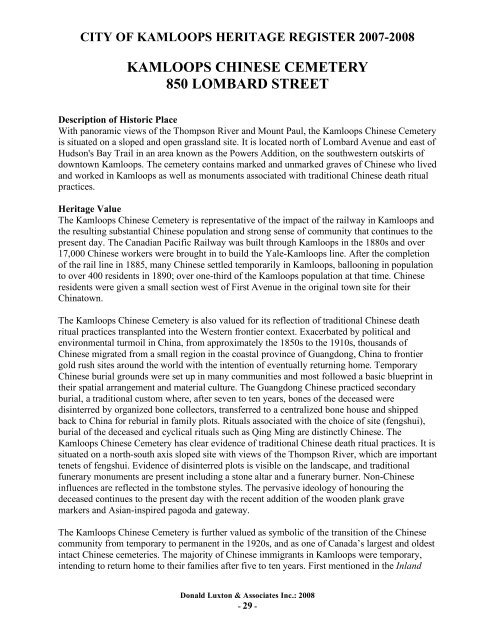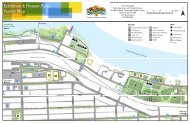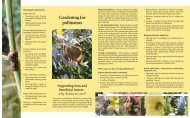Kamloops Heritage Register - City of Kamloops
Kamloops Heritage Register - City of Kamloops
Kamloops Heritage Register - City of Kamloops
You also want an ePaper? Increase the reach of your titles
YUMPU automatically turns print PDFs into web optimized ePapers that Google loves.
CITY OF KAMLOOPS HERITAGE REGISTER 2007-2008<br />
KAMLOOPS CHINESE CEMETERY<br />
850 LOMBARD STREET<br />
Description <strong>of</strong> Historic Place<br />
With panoramic views <strong>of</strong> the Thompson River and Mount Paul, the <strong>Kamloops</strong> Chinese Cemetery<br />
is situated on a sloped and open grassland site. It is located north <strong>of</strong> Lombard Avenue and east <strong>of</strong><br />
Hudson's Bay Trail in an area known as the Powers Addition, on the southwestern outskirts <strong>of</strong><br />
downtown <strong>Kamloops</strong>. The cemetery contains marked and unmarked graves <strong>of</strong> Chinese who lived<br />
and worked in <strong>Kamloops</strong> as well as monuments associated with traditional Chinese death ritual<br />
practices.<br />
<strong>Heritage</strong> Value<br />
The <strong>Kamloops</strong> Chinese Cemetery is representative <strong>of</strong> the impact <strong>of</strong> the railway in <strong>Kamloops</strong> and<br />
the resulting substantial Chinese population and strong sense <strong>of</strong> community that continues to the<br />
present day. The Canadian Pacific Railway was built through <strong>Kamloops</strong> in the 1880s and over<br />
17,000 Chinese workers were brought in to build the Yale-<strong>Kamloops</strong> line. After the completion<br />
<strong>of</strong> the rail line in 1885, many Chinese settled temporarily in <strong>Kamloops</strong>, ballooning in population<br />
to over 400 residents in 1890; over one-third <strong>of</strong> the <strong>Kamloops</strong> population at that time. Chinese<br />
residents were given a small section west <strong>of</strong> First Avenue in the original town site for their<br />
Chinatown.<br />
The <strong>Kamloops</strong> Chinese Cemetery is also valued for its reflection <strong>of</strong> traditional Chinese death<br />
ritual practices transplanted into the Western frontier context. Exacerbated by political and<br />
environmental turmoil in China, from approximately the 1850s to the 1910s, thousands <strong>of</strong><br />
Chinese migrated from a small region in the coastal province <strong>of</strong> Guangdong, China to frontier<br />
gold rush sites around the world with the intention <strong>of</strong> eventually returning home. Temporary<br />
Chinese burial grounds were set up in many communities and most followed a basic blueprint in<br />
their spatial arrangement and material culture. The Guangdong Chinese practiced secondary<br />
burial, a traditional custom where, after seven to ten years, bones <strong>of</strong> the deceased were<br />
disinterred by organized bone collectors, transferred to a centralized bone house and shipped<br />
back to China for reburial in family plots. Rituals associated with the choice <strong>of</strong> site (fengshui),<br />
burial <strong>of</strong> the deceased and cyclical rituals such as Qing Ming are distinctly Chinese. The<br />
<strong>Kamloops</strong> Chinese Cemetery has clear evidence <strong>of</strong> traditional Chinese death ritual practices. It is<br />
situated on a north-south axis sloped site with views <strong>of</strong> the Thompson River, which are important<br />
tenets <strong>of</strong> fengshui. Evidence <strong>of</strong> disinterred plots is visible on the landscape, and traditional<br />
funerary monuments are present including a stone altar and a funerary burner. Non-Chinese<br />
influences are reflected in the tombstone styles. The pervasive ideology <strong>of</strong> honouring the<br />
deceased continues to the present day with the recent addition <strong>of</strong> the wooden plank grave<br />
markers and Asian-inspired pagoda and gateway.<br />
The <strong>Kamloops</strong> Chinese Cemetery is further valued as symbolic <strong>of</strong> the transition <strong>of</strong> the Chinese<br />
community from temporary to permanent in the 1920s, and as one <strong>of</strong> Canada’s largest and oldest<br />
intact Chinese cemeteries. The majority <strong>of</strong> Chinese immigrants in <strong>Kamloops</strong> were temporary,<br />
intending to return home to their families after five to ten years. First mentioned in the Inland<br />
Donald Luxton & Associates Inc.: 2008<br />
- 29 -

















